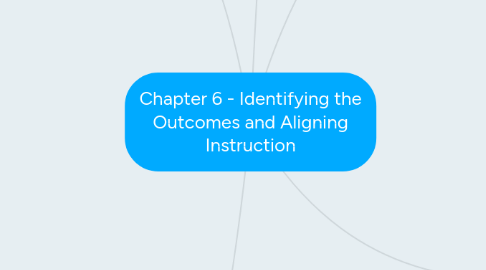
1. Writing Outcomes that Communicate to the Learner
1.1. Learning objectives define the competencies (or capably performed skills) that your learners should posses after they receive instruction
1.2. Learning activities are the things the instructor or the instruction does, or the events that learners participate in during the learning experience
1.3. Instructional intentions are the learning tasks and mental processing you are trying to facilitate through the structure and flow of you instruction
1.4. Blooms Taxonomy for Cognitive Objectives
1.4.1. Thinking skills that progress from lower-order thinking skills (LOTS) of remembering, understanding, and applying content, to higher-order thinking skills (HOTS) that build on those lower skills including analyzing, evaluating, and creating
1.5. Six facets of understading
1.5.1. Explain it
1.5.1.1. providing complete facts and data to support the explaination
1.5.2. Interpret it
1.5.2.1. showing through examples, meaningful stories and analogies that he or she has a grasp of essence of the topic
1.5.3. Apply it
1.5.3.1. effectively using it and adapting it to new situations
1.5.4. Demonstrate Perspective
1.5.4.1. including knowledge of the big picture and an informed and critical eye
1.5.5. Empathize
1.5.5.1. finding value in something that mere observers might not perceive
1.5.6. Exhibit self-knowledge
1.5.6.1. about what is understood or not and why, so that he or she can direct his or her own learning of the topic
1.6. Begin with the end in mind to
1.6.1. Identify the desired results
1.6.2. Determine what constitutes acceptable evidence of those results
1.6.3. Plan learning experiences and instruction that are geared toward producing those results
1.6.4. To begin with the end in mind means to start with a clear understanding of your destination. It means to know where youre going so that you better understand where you are now so that the steps you take are always in the right direction. - Steven R. Covey
2. Communicating Relevant Outcomes
2.1. Learning outcomes provide the mist benefit when learners are aware of them and understand that they are meant to provide direction for learning specific materials
2.2. Communicate Relevance by
2.2.1. Illustrating how concepts and skills relate to the learners current or future needs or goals
2.2.2. Describing how the new material might relate to the learners past experiences, or how others have used the info in their lives
2.2.3. Providing guidance on how the learner can customize the experience to self-motivate
2.3. Connect with the learners emotional commitment to learning without boring them, as with a scenario that illustrates their need for the skills your instruction is addressing
2.3.1. Present the outcomes to leaners at the beginning of the instruction, and then provide frequent checks for understanding, along with feedback on the results of those assessments
2.3.1.1. This enables learners to monitor and track their own progress against the outcomes and if their progress is not satisfactory to access remedial materials or ask for help
2.4. Learning outcomes should be reviewed and approved by your key stakeholders
2.4.1. A table of aligned outcomes, assessments, and strategies fully communicate your plans and will yield more constructive feedback
3. Learning outcomes evolve from the identified goals and KASIs, are written from the viewpoint of the learner, and communicate precisely what the learner should know, feel, and/or be able to do following the learning experience
3.1. Outcomes indicate how the learner wil be assessed and provide guidance on the strategies to use for the learning experience
3.2. Outcomes, assessments, and teaching/learning strategies in your design should reflect each other or be aligned, so that they support the learner in mastering the required knowledge and skill
3.3. Provide accountability and a way to measure the success of your instruction
3.4. Notable Non-Example (Missing the Target - informing the students of the intended outcomes for the instruction prior to teaching them the content
4. Tips on Defining Outcomes
4.1. Define the type of outcomes to be identified and the level of detail to be assessed
4.2. Write outcomes that communicate the desired behavior, conditions, and standards
4.3. Align outcomes to assessments and strategies
4.4. Plan how to convey the outcomes and communicate their relevance to learners
5. Outcome Types
5.1. Behavioral - emphasize performance and competencies
5.2. Cognitive - focus on the way knowledge is acquired, encoded, and retrieved
5.3. Instructivist
5.3.1. Presents clear goals and mastery-based objectives at the beginning of the instruction to facilitate the learning process
5.3.2. Addresses discrete "chunks" of learning that represent degrees of growth in skills and thinking, and incrementally assesses learners on each chunk
5.3.3. Elaborates on the relevance of the outcomes to learners, and makes a distinction between "need-to-know" and "nice-to-know" information and skills
5.3.4. Characterized as being SMART
5.3.4.1. Specific
5.3.4.2. Measurable
5.3.4.3. Action oriented
5.3.4.4. Realistic
5.3.4.5. Timely
5.3.5. ABCD - Audience, Behavior, Conditions, Degree
5.4. Specific Learning
5.4.1. Specific outcomes improve intentional learning, but can lead to a decrease in incidental learning
5.4.2. Instruction meant to foster exploration of a topic, specific objectives might narrow the learners focus and limit their learning
5.4.2.1. Provide learners with more general goals to set the direction for their learning, and then encourage them to personalize those goals or define related outcomes that address their specific interests

